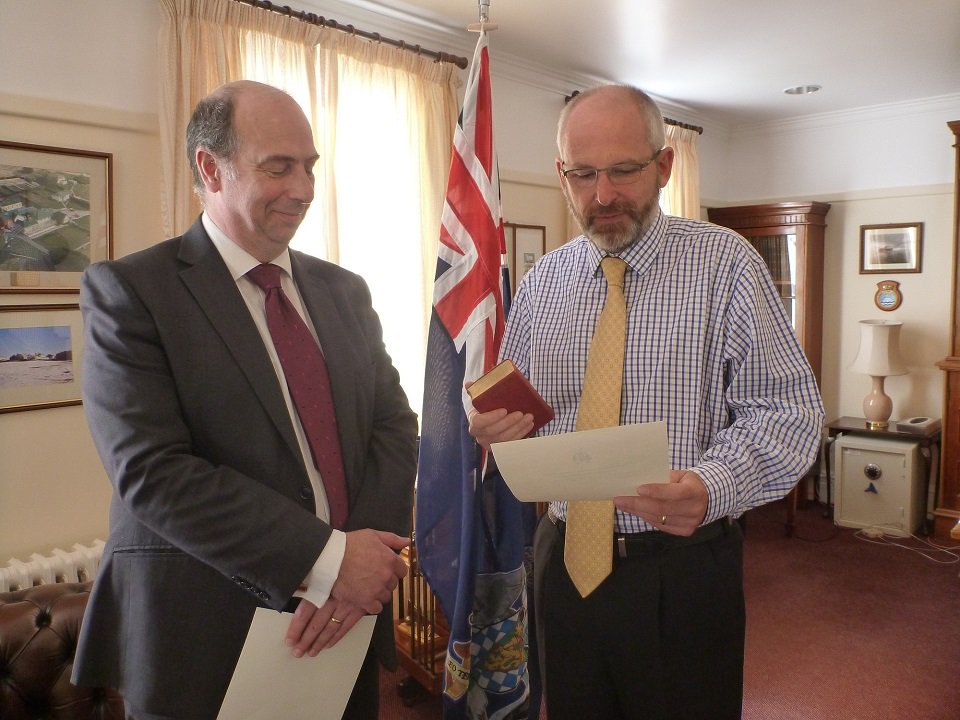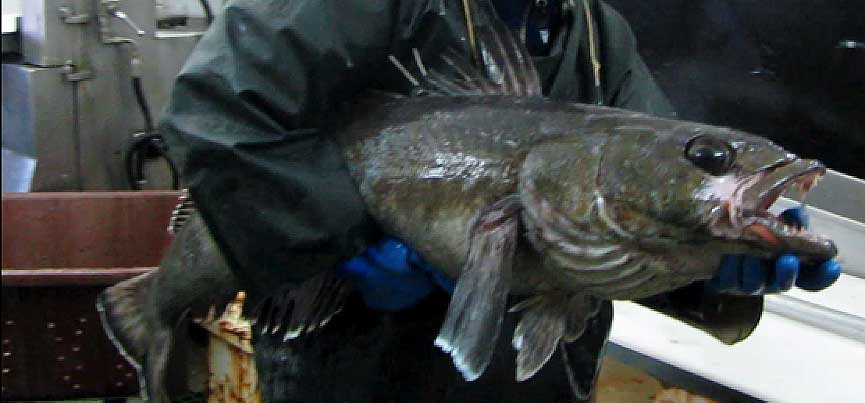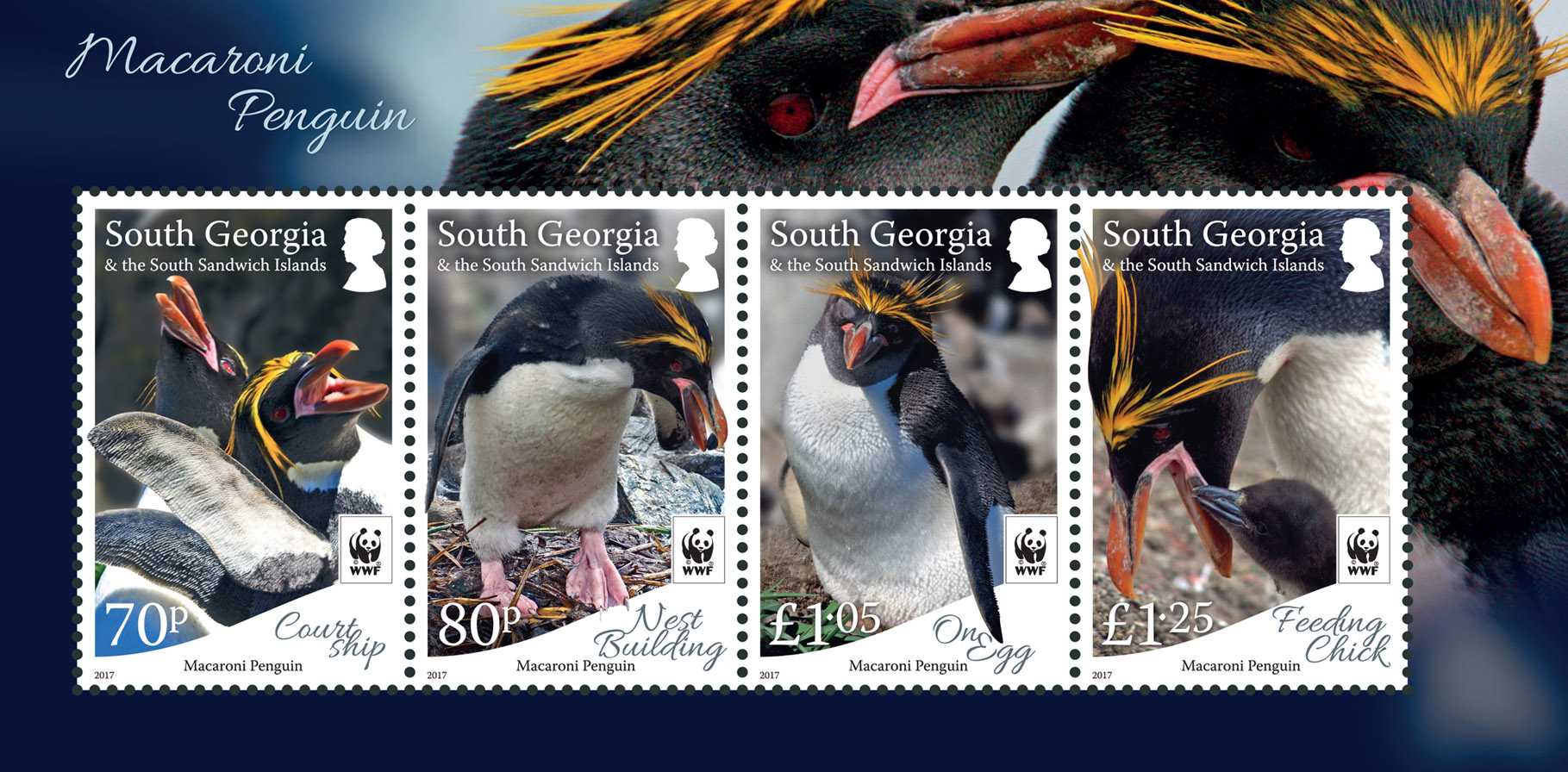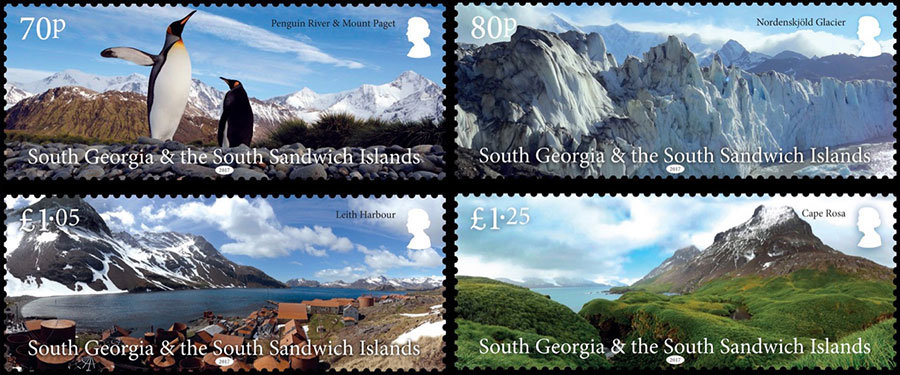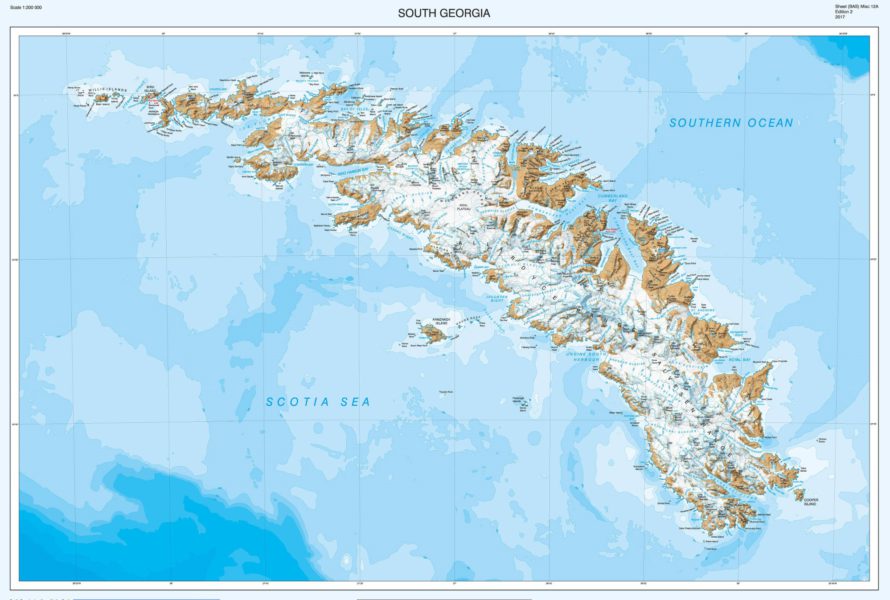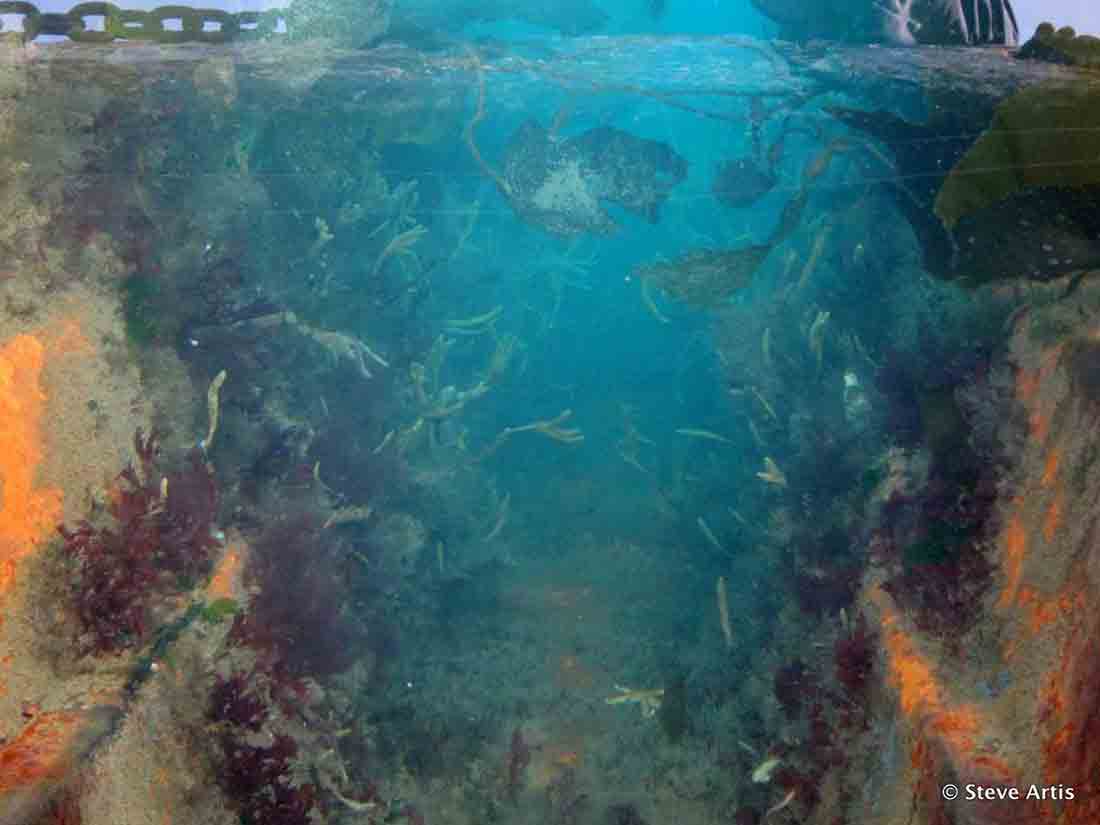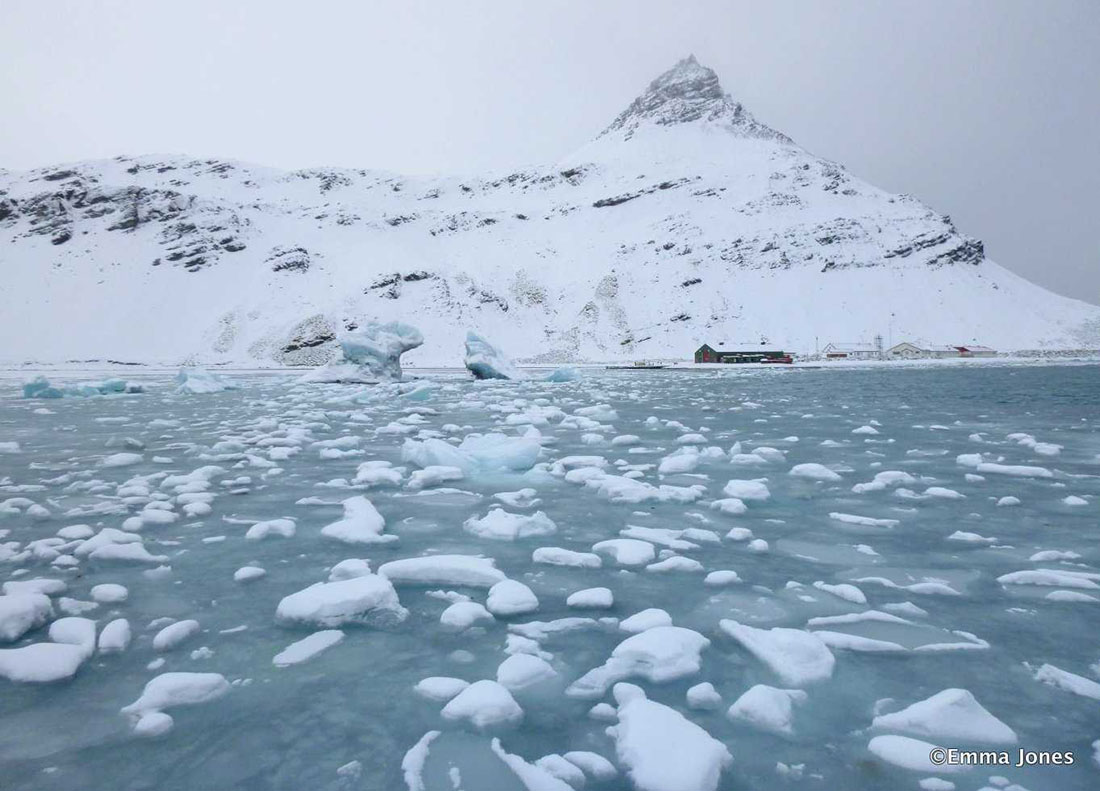This newsletter is not produced by GSGSSI; it does not necessarily reflect their views.
To subscribe to the SGIsland News Alerts list click here
Nigel Phillips has been sworn in as Her Majesty’s Commissioner for South Georgia & the South Sandwich Islands. Mr Phillips also took the oath of office to become the 36th Governor of the UK Overseas Territory.
With regards to South Georgia & the South Sandwich Islands, Mr Phillips said:
“Speaking of beautiful places, it is appropriate that I record what a privilege it will be to be appointed Her Majesty’s Commissioner for South Georgia & the South Sandwich Islands. Encompassing as it does the final resting place of one of our greatest explorers and leaders, Sir Ernest Shackleton, it is a region of significant historical interest. It is also hugely important scientifically. I am proud as a British citizen that the region is recognised as being managed in accordance with the highest possible standards. I look forward to working with the Government of South Georgia & the South Sandwich Islands in continuing this noble legacy.”
https://www.gov.uk/government/news/new-falklands-governor-sworn-in
GSGSSI held its annual stakeholder meeting on Thursday 14 September. Hosted by the Foreign & Commonwealth Office and chaired by Jane Rumble, Head of Polar Regions Department, the meeting drew over 70 representatives from South Georgia stakeholder organisations. GSGSSI set out an overview of the year and forward look to 2017/18 and this year invited presentations from stakeholders involved in some of South Georgia’s current projects. Stakeholders heard from the South Georgia Heritage Trust about the forthcoming rodent eradication monitoring work, Purcell heritage consultants about our draft heritage strategy and framework, UNEP-WCMC on our terrestrial protected area work, and GSGSSI gave an update on plans for the Marine Protected Area 5-year review. The meeting concluded with a reception on Whitehall.
A copy of the Government’s presentation, Annual Report of Progress – 2017, is available here.
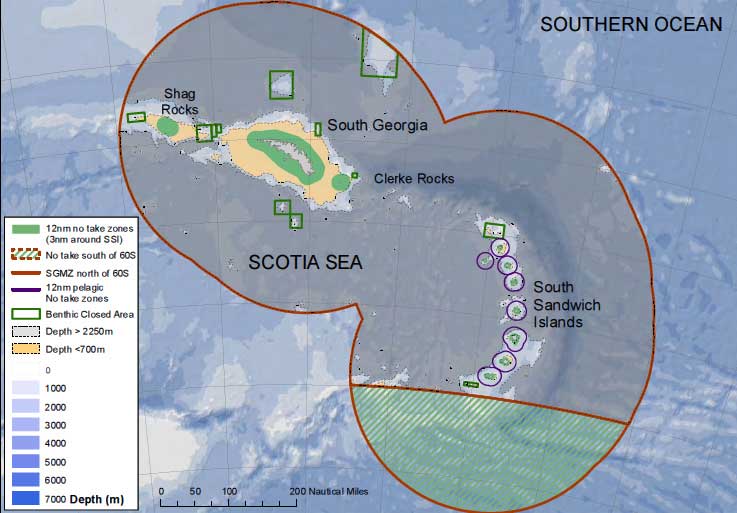 The Government recently commenced the first 5-year review of its Marine Protected Area (MPA). Written submissions have been invited from stakeholders to inform the review process and these will published on the Government’s website, together with future updates, at www.gov.gs/environment/marine-protected-area. Work has also taken place, via a British Antarctic Survey hosted workshop, to review existing data and research relevant to the MPA including research undertaken since the MPA was designated. This will help to identify the requirements for future research and will form part of the background to the review process.
The Government recently commenced the first 5-year review of its Marine Protected Area (MPA). Written submissions have been invited from stakeholders to inform the review process and these will published on the Government’s website, together with future updates, at www.gov.gs/environment/marine-protected-area. Work has also taken place, via a British Antarctic Survey hosted workshop, to review existing data and research relevant to the MPA including research undertaken since the MPA was designated. This will help to identify the requirements for future research and will form part of the background to the review process.
The Government is aware of some recent media interest in the review process. While the Government is grateful for this interest it is engaging widely with stakeholders to ensure it is able to take into account the full range of stakeholder views in the review process. An ad-hoc advisory panel has been constituted by the Government comprising representation from scientists, fishing operators, non-governmental organisations and external experts. This will convene in November 2017 for a two-day workshop and tasked to report to Government by end of May 2018.
The Government has concluded its consultation on changes to its toothfish licensing and management arrangements.
The toothfish fishery is one of the highest-scoring Marine Stewardship Council certified fisheries, underpinned by scientific research, ecosystem-based precautionary management, and careful monitoring and enforcement. It has developed following close collaboration between operators, scientists, NGOs and Government. The Government is proposing a number of changes to the management of the fishery in support of its fisheries objectives. Key among these is a proposal to extend the toothfish licensing period from 2 to 4 years (with a review planned after 2 years). The establishment of a 4-year licensing regime would mean a number of changes to the way in which the fishery operates including the application assessment process and the compliance and enforcement regime. Details of the proposed changes were set out in this consultation.
The outcomes will be published on this website when available.
Marine Environment & Fisheries Manager Appointment
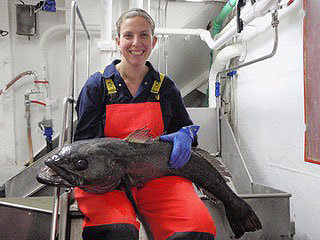 Sue Gregory has been appointed to the position of Marine Environment & Fisheries Manager following an open recruitment process. Sue has been working with the Government for the past 5 months on secondment from the British Antarctic Survey where she has spent the last 8 years as a fisheries ecologist for the King Edward Point project funded jointly by the Government and the Foreign & Commonwealth Office. Sue has a strong background in marine biology and fisheries management and will be closely involved in the forthcoming 5-year review of the Marine Protected Area and development of future licensing arrangements and management of the fishery. After a short break at the end of her current secondment Sue will be joining the Government at the start of November, spending time in both the UK and the Falkland Islands in undertaking her role.
Sue Gregory has been appointed to the position of Marine Environment & Fisheries Manager following an open recruitment process. Sue has been working with the Government for the past 5 months on secondment from the British Antarctic Survey where she has spent the last 8 years as a fisheries ecologist for the King Edward Point project funded jointly by the Government and the Foreign & Commonwealth Office. Sue has a strong background in marine biology and fisheries management and will be closely involved in the forthcoming 5-year review of the Marine Protected Area and development of future licensing arrangements and management of the fishery. After a short break at the end of her current secondment Sue will be joining the Government at the start of November, spending time in both the UK and the Falkland Islands in undertaking her role.
Macaroni Penguin Stamps
Macaroni penguins (Eudyptes chrysolophus) are a species of crested penguin first described from the Falkland Islands and are one of six species in the genus Eudyptes. Found throughout the sub-Antarctic they are named for the yellow feathers sticking out of the side of their heads which, to the early sailors who discovered them, looked like a flamboyant style of dress common in the 18th century known as Maccaronism made famous by the song ‘yankee doodle’.
Macaroni penguins have a varied diet consisting of crustaceans, squid and fish which will vary with locality and with season. It is thought that krill account for around 90% of their food during the breeding season and globally macaroni penguins are thought to consume approximately 9.2 million tonnes of krill per year. Birds on South Georgia forage as far as 50 km off shore and typically make short dives of a couple of minutes’ duration to depths of between 15-70 m.
Thought to be the most abundant species of penguin worldwide, on South Georgia & the South Sandwich Islands there are currently approximately 1 million pairs with the largest colonies being on Bird Island and the Willis Islands. Unfortunately, populations both globally and in South Georgia are in decline with the South Georgia population declining by 50% from the mid-1970s to mid-1990s. This has led them to being classified by the International Union for Conservation of Nature Red List as Threatened.
On South Georgia & the South Sandwich Islands actions have been taken to support their conservation through the designation of a 1 million km2 Marine Protected Area. This includes measures to prevent competition for food such as the designation of areas closed to all fishing activity within 12 nm of land and a seasonal closure of the krill fishery in the summer months when the penguins are rearing chicks and at their most vulnerable.
About the Stamps:
70p Courtship
Macaroni penguins breed in large raucous colonies and are highly social. This has led to the development of a great range of visual and vocal displays which peak during the breeding period which starts in late October. In what is known as the ‘ecstatic display’ birds go through a highly choreographed routine of bowing, extending their head and neck upward until near vertical before waving their head from side to side and braying loudly.
80p Nest Building
Eggs are laid in early November in a shallow scrape in the ground lined with a few stones or pebbles. When these are in short supply, they are often ‘borrowed’ from a neighbour leading to frequent squabbles adding more to the noise and commotion in the densely packed colonies. Bill jousting, pecking and flipper whacking are common sights.
£1.05 Incubation
Like many penguin species, females usually lay two eggs each season, but uniquely in macaroni penguins the second egg is much larger than the first (in other species of penguin it is usually the first egg which is larger). Once the second egg is laid, the first is discarded and is unlikely to survive. Parents share incubation duties, taking it in turn to go to sea to feed. Nevertheless, the prolonged fasting still takes its toll and adults can lose around a third of their body weight in this period.
£1.25 Chick rearing
When the chick is born it has no feathers and is highly vulnerable to cold and if left unattended would be easy prey for skua and giant petrels. In the first few weeks of life the male penguin cares for the newly born chick at the nest and the female brings food to it every two to three days. After this time, the chicks have grown a few more feathers and are to able stray away from their parents a little more and form crèches to keep warm and stay protected. At around two months, the chicks will have grown their adult feathers and will be ready to go to sea.
Landscapes Stamps
Renowned for its lush green coastal plain crowded with wildlife and an interior filled with craggy mountains and majestic glaciers, South Georgia has a landscape for every occasion. The dramatic vistas that are found on South Georgia have taken millennia to form through the action of ice, waves, tectonic forces and the rise and fall of sea levels. Overlaid onto this natural splendour are human factors and even today, evidence of the industry and enterprise of the whalers has left its mark on the landscape, at some sites.
Printed in an unusual 24 x 60 mm format to represent the wide vistas South Georgia is renowned for, the stamps cover some of the main habitat types to be found in the Territory and celebrate their beauty and diversity.
About the stamps:
70p – Penguin River and Mount Paget, Cumberland Bay.
Towering at 2,915 m above sea level, Mount Paget is the highest mountain on South Georgia. Its distinctive saddle shape peak forms part of the Allardyce range and on a clear day forms an imposing backdrop to many South Georgia scenes. Formed from alternating layers of sandstone and mudstone, which in places are several meters thick, the rocks in the Cumberland Bay formation have an unusual striped appearance.
On the coast, the landscape of Cumberland Bay is markedly softer and more hospitable. Penguin River flows lazily across a glacial outwash plain and its lower reaches are home to abundant wildlife including fur seals and penguins.
80p – Nordenskjöld Glacier
Over 50% of South Georgia is permanently covered with ice and glaciers and the Nordenskjöld is a particularly spectacular example. With its origins high in the Allardyce range, the glacier tumbles directly into Cumberland East Bay. Its surface is fractured with deep crevasses that form as the ice moves at different speeds over the undulating rock beneath. At its terminus, a 3 km wide face plunges into the sea and during the summer months large chunks can be seen calving off the front and often fill the bay with ice. Although retreating more slowly than some of South Georgia’s other glaciers, it has still retreated more than 1 km in the last 30 years.
The striking blue colour of the glacier occurs because over time the huge weight of accumulated snow squeezes air bubbles from the ice meaning light can penetrate more deeply. Red and yellow light is absorbed and blue light, which has a longer wave length, is reflected giving the ice a beautiful azure colour.
£1.05 – Leith Harbour
Nowhere is South Georgia’s industrial past more striking than at Leith Harbour. Nestled beneath the scree slopes of the Concordia Peak massif, Leith was known as a sheltered anchorage from as far back as the early 1800s when it was used by the early sealers. The steeply sloping shore line and clear approaches from the sea made it an ideal deep water port for shore-based whaling operations and for nearly 70 years the site was a hive of industry. The now abandoned station complex was once the largest on the island and the distinctive red rust coloured factory buildings, warehouses and workshops bare silent witness to decades of human exploitation of the environment and the animals that lived in it.
£1.25 – Cape Rosa
At the coast, the warmer temperatures and fertile soils can support lush green landscapes dominated by tussac grass, which is home to a huge diversity of invertebrates and large numbers of burrowing seabirds, such as white-chinned petrels and Antarctic prions. At Cape Rosa, wave-cut platforms fringe the shoreline, which is indented by a series of narrow inlets, of which ‘Cave Cove’ is one of the most distinctive. Famously, this is the site where Ernest Shackleton made landfall after his epic journey across the Southern Ocean and sheltered for four days to build up strength before making his famous crossing of South Georgia.
First Day Cover image – View from the top of Mount Duse
Mount Duse dominates the skyline of King Edward Cove and from its summit at more than 500 m above sea level there are fantastic views across the Allardyce Range and beyond. Famously Shackleton’s photographer Frank Hurley took a picture from the same spot before embarking on the fateful Imperial Trans-Antarctic Expedition. From this vantage point, the full range of South Georgia’s varied and impressive landscapes can be admired although in 1914 Hurley would have seen whaling vessels and Endurance moored in the bay rather than the cruise ships and fishing vessels which are seen there today.
By the South Georgia Heritage Trust (SGHT)
In the coming season a monitoring survey will take place on South Georgia, led by Project Director Dickie Hall, to find out if the SGHT Habitat Restoration project on South Georgia has achieved its goal of eradicating rodents from the island. The team determined to answer this question will include some new members of the canine variety. Three terrier dogs Will, Wai and Ahu and their expert handlers, Miriam Ritchie and Jane Tansell hail from New Zealand. They are hugely experienced in seeking out elusive rodents, having searched sub-Antarctic Macquarie Island and many other locations following eradication attempts. Team Dog will travel south on the MV Pharos SG, courtesy of GSGSSI, to join a veteran group of South Georgia field workers. With backup assistance from Thies Matzen and Kicki Ericson on yacht Wanderer III, their combined task will be to track down any pockets of rodents that might remain on South Georgia.
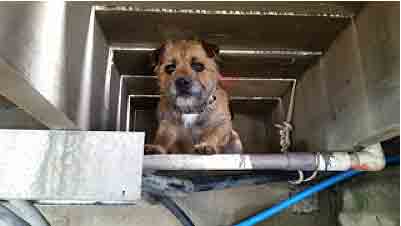
Ahu on the trail of a rat under a wharf.
The Habitat Restoration project’s baiting work to eradicate rodents was carried out by the South Georgia Heritage Trust in early 2011, 2013 and 2015. International guidelines suggest that at least two years should elapse after baiting before an area can be considered to have been cleared of rodents. As the survey work will begin in November 2017 it will be close to three years since even the most recent bait application, so the results will be robust – although in an area the size of South Georgia it is never possible to say definitively that no rodents remain.
The 2017-18 monitoring work will revisit a large sample of the areas baited by helicopter in Phases 2 and 3 of the Habitat Restoration project. (Phase 1 covers KEP and Grytviken and so has a year-round onsite team of rodent detectors in the form of BAS scientists and Government officers!) MV Pharos SG and the Hans Hansson will transport some of the team to the remote sites treated in 2013 and 2015, with backup from Wanderer III, while the more accessible areas are surveyed on foot. Once at the sites, a combination of inert detection devices such as wax tags, stakes and camera traps will be used alongside the sniffer dogs to provide a ‘belt and braces’ approach to detection. Devices are not infallible – they can be washed away or displaced by passing wildlife and some rodents are wary of chewing a stick, even one soaked in peanut oil or another tasty treat. Using dogs in addition to inert devices avoids these limitations and allows a far wider area to be surveyed.
At the conclusion of the monitoring survey in April it will finally be possible to say if the eradication has succeeded and South Georgia is once again free of the rodent invaders that blighted its indigenous seabirds for two centuries.
A team of cartographers at British Antarctic Survey (BAS) has re-produced a high-resolution updated map of the sub-antarctic island of South Georgia. The island, situated at 37°W 54°10’S is a haven for wildlife, a centre for wildlife and fisheries research and famous for the epic voyage by Sir Ernest Shackleton and his men just over a century ago.
Last updated in 2004, the map has new features including new bays and lakes created by recent glacier retreat. An interesting addition is a detailed map of the Shackleton Crossing, which is popular for mountaineers wishing to follow in the path of the great explorer’s 1916 expedition. This was produced in collaboration with the expedition and advisory panel at the Government of South Georgia & South Sandwich Islands, who frequently advise visitors on routes across the island.
Head of the Mapping and Geographic Information Centre at BAS, Dr Adrian Fox said:
“We are really pleased with our new map of South Georgia, which will appeal to mountaineers and tourists visiting the island. It’s important to frequently update maps of this region as the environment is changing. For instance, on the north side of the island there is the newly formed Twitcher Bay, formed due to the retreat of Twitcher Glacier of over 4 km since the last edition of the map, and the extension of Cumberland West Bay by more than 6 km due to the retreat of Neumayer Glacier.”
https://www.bas.ac.uk/media-post/new-map-of-south-georgia-unveiled/
Rodent eradication scaled up: clearing rats and mice from South Georgia
The Subantarctic island of South Georgia lost most of its birds to predation by rodents introduced by people over 2 centuries. In 2011 a UK charity began to clear brown rats Rattus norvegicus and house mice Mus musculus from the 170 km long, 3,500 km2 island using helicopters to spread bait containing Brodifacoum as the active ingredient. South Georgia’s larger glaciers were barriers to rodent movement, resulting in numerous independent sub-island populations.
UK Overseas Territories have 4 million sq. km. of marine protected areas
The UK and the Overseas Territories are custodians to the fifth-largest marine estate in the world and as such have an obligation to protect species and habitats against detrimental human impacts. This includes areas surrounding St. Helena, Ascension, South Georgia and South Sandwich.
Tom Crean’s granddaughter tells how she broke her leg
When the Endurance became trapped in pack ice, Crean and the crew navigated a flimsy boat through mountainous waves and freezing temperatures to reach the remote island of South Georgia where the men then trekked 48km across sheer peaks to raise the alarm.
Iceberg fuels fears of sea level rise
Helen Amanda Fricker, an Antarctic expert at the Scripps Institution of Oceanography, told the Post the iceberg would drift north in currents and would pass west of South Georgia and the South Sandwich Islands.
https://www.sunshinecoastdaily.com.au
Giant cracks are still spreading in an Antarctic ice shelf where a trillion ton iceberg broke free
It will most likely follow a northeasterly course, heading roughly for South Georgia and the South Sandwich Islands.
http://www.dailymail.co.uk/sciencetech
Fight or Forage
When photographer Chris Fallows spotted this southern giant petrel (Macronectes giganteus) feasting on a dead Antarctic fur seal pup (Arctocephalus gazella) near South Georgia Island, he knew to keep his distance.
http://www.biographic.com/posts/sto/fight-or-forage
South Georgia: How to beat a rat plague
Poison, dogs and helicopters – how scientists pulled out all the stops to protect South Georgia’s wildlife from a plague of rats.
http://www.dw.com/en/south-georgia-how-to-beat-a-rat-plague
Unexpected facets of Antarctica emerge from the labs
Peter Ryan, from the University of Cape Town in South Africa, observed and counted bird populations. He discovered that one of the largest colonies of king penguins, on Pig Island in the Crozet archipelago, had declined drastically – he estimates the numerical loss to be around 75%. “That’s around half a million animals,” says Walton. “We don’t know if they’ve died or migrated to other colonies, like the one in St. Andrews Bay, in South Georgia, which is actually in a growth phase.”
https://phys.org/news
U-M biologist teaches microbe-hunting skills honed at sea
University of Michigan biologist Melissa Duhaime recently spent a month on a Russian research vessel off the coast of Antarctica, filtering bacteria, viruses and other microorganisms from thousands of gallons of seawater.
March of the ever-endearing penguin!
California-based Ira Meyer has been photographing penguins around Antarctica and the South Georgia region for more than a decade and he says that he never tires of documenting the characterful critters.
http://www.dailymail.co.uk/travel
Walking in Shackleton’s footsteps
It is without doubt a remarkable story given the many challenges he and his crew had to overcome after losing their ship, the Endurance. For months they drifted on sea-ice, before making a lifeboat dash to Elephant Island, followed by a hazardous sail across the Southern Ocean to South Georgia.
Share[addtoany]


